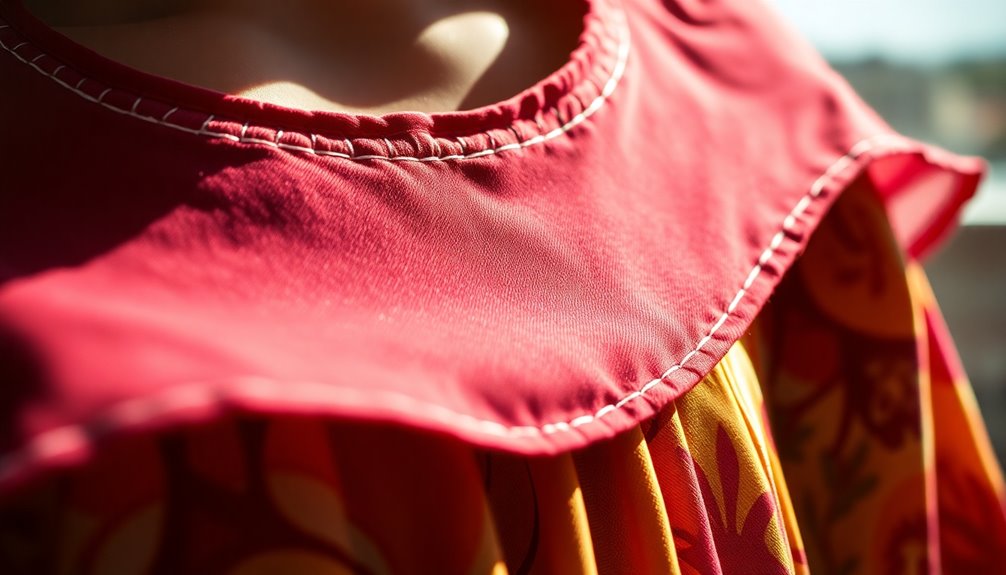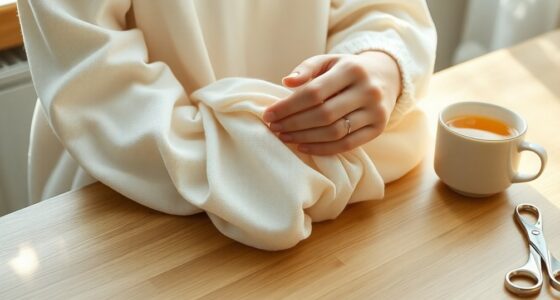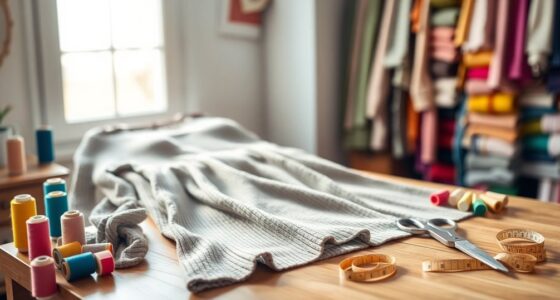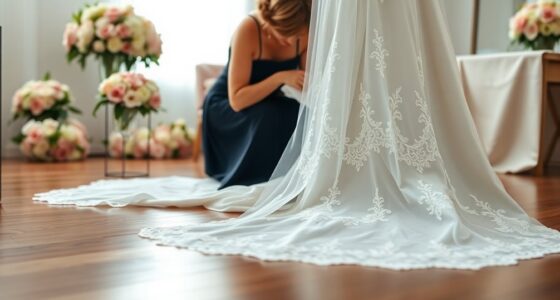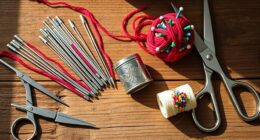A yoke in sewing is an essential part that provides structure at the shoulders or neckline of garments, enhancing your fit and overall design. It supports the garment and allows for better draping by absorbing excess fabric, ensuring comfort and movement. Yokes come in various shapes and styles, influencing both silhouette and aesthetics. If you're curious about the different types of yokes and their functions, there's much more to discover!
Key Takeaways
- A yoke in sewing is a structural element that provides support at the shoulders or neckline of a garment.
- Yokes can be designed as straight or curved shapes, enhancing fit and comfort while following body contours.
- They help absorb dart values, allowing for a smoother fit and ease of movement in garments.
- Yokes are often incorporated in shirts, dresses, and coats, influencing the overall silhouette and style.
- Decorative elements and contrasting fabrics on yokes can significantly elevate a garment's visual appeal.
Understanding the Yoke in Garment Design
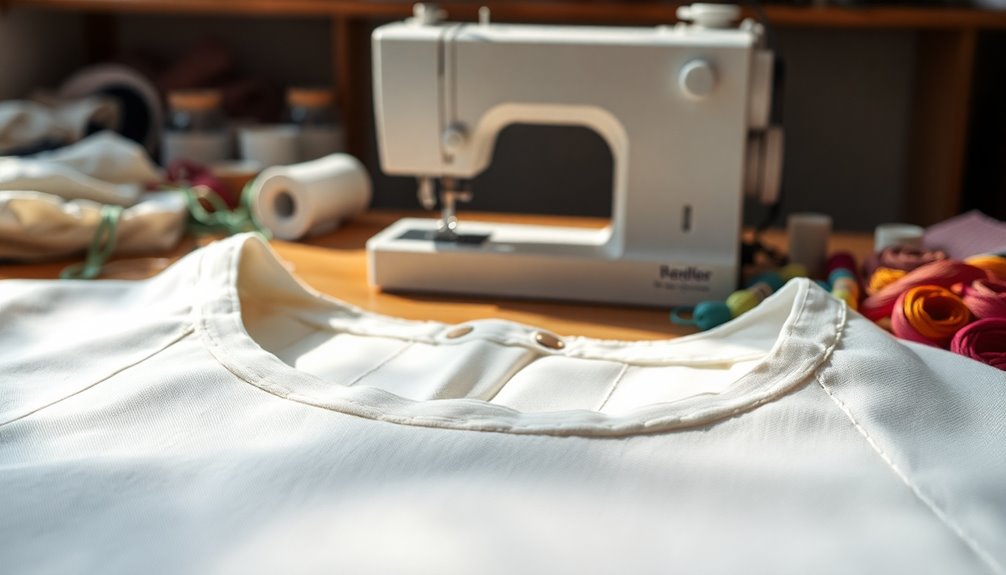
The yoke is an essential element in garment design, serving as a horizontal panel that adds structure at the shoulders or neckline.
When you're crafting shirts, dresses, or coats, the yoke provides that needed shaping and support. You can choose to make it as one continuous piece or separate front and back sections, allowing for creative variations.
This feature plays a significant role in tailoring by absorbing dart values, ensuring a smooth fit and facilitating ease of movement across your shoulders and upper back.
Yokes can come in various shapes—straight, curved, or pointed—and each influences the overall silhouette.
Don't forget to take into account decorative elements like gathers or pleats, which can enhance both functionality and style in your designs.
Historical Significance of Yokes in Fashion
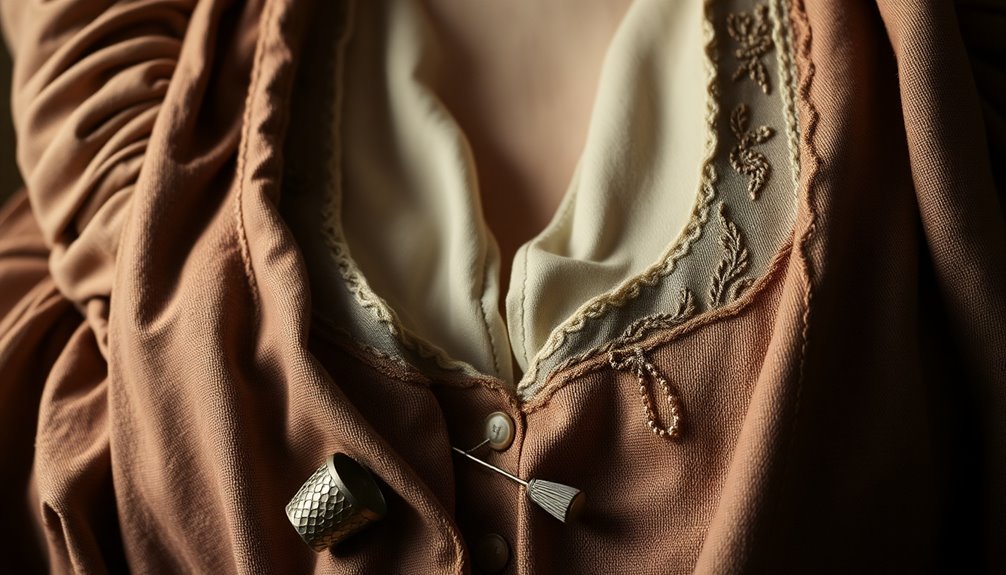
You might be surprised to learn that yokes have deep historical roots, connecting ancient garments to modern fashion.
Across various cultures, yokes have showcased unique design variations that reflect societal values and needs.
As you explore their evolution through different eras, you'll see how yokes shifted from practical elements to key features of style and expression.
Ancient Garment Connections
While yokes may seem like a simple design element, they've played an essential role in the evolution of fashion since ancient times. The yoke has been a significant component in connecting different fabric panels, providing structural support and enhancing aesthetics.
In traditional clothing, yokes often displayed intricate designs, showcasing craftsmanship and cultural significance. Historical garments, like Victorian-era dresses and peasant blouses, utilized yokes to shape silhouettes and improve fit.
Western-style shirts, originally designed for cowboys, relied on yokes for durability and ease of movement, vital for physical labor. Over the centuries, yoke styles evolved, reflecting changing fashion trends and the needs of wearers, proving their lasting impact on clothing design.
Cultural Design Variations
Yokes aren't just a historical remnant; they've adapted and transformed across cultures, reflecting unique traditions and practical needs. From Victorian elegance to peasant practicality, back yokes serve diverse purposes in garment design.
| Culture | Yoke Style |
|---|---|
| Victorian | Pleated yokes for elegance and intricate designs |
| Eastern European | Smocked yokes for decoration and ease of movement |
| Western Cowboy | Durable yokes built for rugged outdoor work |
These variations highlight how yoke designs evolve with social norms. In contemporary fashion, you'll find innovative silhouettes and contrasting fabrics, showcasing the yoke's role in blending functionality with artistic expression. Embracing these cultural design variations deepens your appreciation of yokes in sewing.
Evolution Through Eras
As fashion evolved through the ages, the yoke emerged as a crucial element, seamlessly blending function with style.
Originally, yokes served a practical purpose, connecting and supporting garment panels in ancient attire. In the Victorian era, you'd see yokes adorned with intricate pleating and embroidery, highlighting the period's love for detail.
Fast forward to the 19th century, and yokes became essential in Western-style shirts, offering both durability and aesthetic appeal for cowboys.
The 20th century brought modern tailoring techniques, reshaping yoke designs to fit contemporary styles.
Today, yokes remain significant, showcasing innovative patterns that reflect current trends and cultural influences in the fashion industry.
You can appreciate how the yoke has transformed while retaining its core essence throughout history.
Types of Yoke Designs and Their Functions
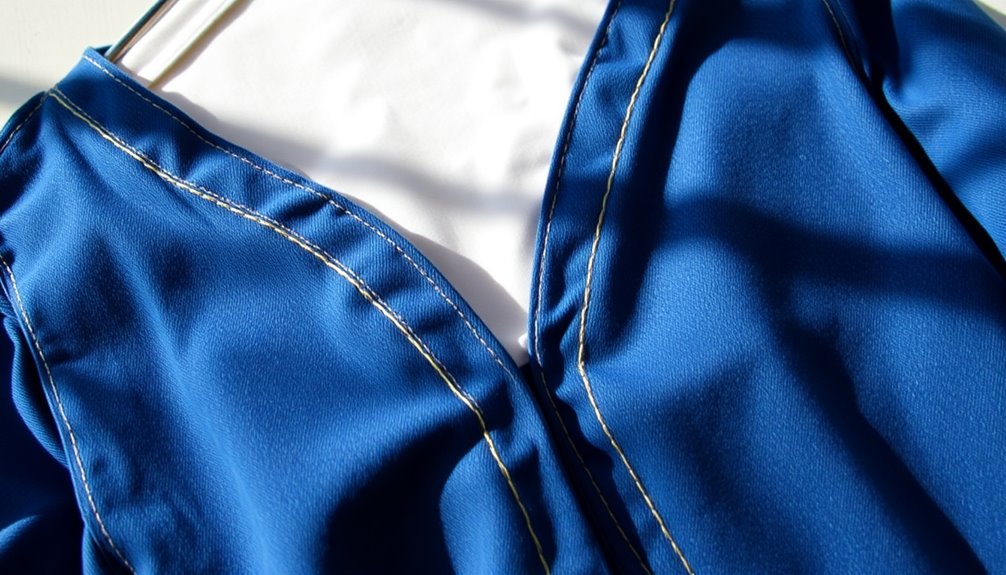
When you're choosing a yoke design, you'll notice the distinct features of straight and curved styles.
A straight yoke offers a clean, structured look, while a curved yoke can enhance the garment's shape and fit.
Understanding these differences helps you create a piece that not only looks great but also feels comfortable.
Straight Yoke Design
A straight yoke design offers a sleek, structured look that enhances the fit of shirts and blouses. This design features a horizontal panel that runs across the back or front, providing vital structure. You can cut the yoke as a single piece or as separate front and back panels, giving you flexibility in your patterns.
Often, straight yokes incorporate darts or pleats to improve fit, especially around the shoulders and upper back, accommodating your body's natural contours. Additionally, you can elevate the aesthetic by using contrasting fabrics or decorative elements, making the yoke a focal point.
Ultimately, straight yokes are essential for achieving a clean finish, preventing raw edges, and ensuring durability and comfort in your garments.
Curved Yoke Features
How do curved yokes enhance the fit and comfort of your garments? Curved yokes are tailored to follow your body's natural contours, improving garment fit while providing comfort. They adapt to various body types, accommodating shoulder widths and back curves for a personalized look. The curvature influences the silhouette, allowing for styles from fitted to relaxed. Additionally, curved yokes can feature darts or pleats for ease of movement, making them practical as well as stylish. You can elevate your designs further by adding decorative elements, like contrasting fabrics.
| Feature | Function |
|---|---|
| Contoured Design | Enhances fit and comfort |
| Accommodating Sizes | Fits various body types |
| Silhouette Influence | Affects overall garment style |
| Darts/Pleats | Allows for ease of movement |
| Decorative Elements | Adds visual interest and uniqueness |
The Role of Yoke in Garment Construction
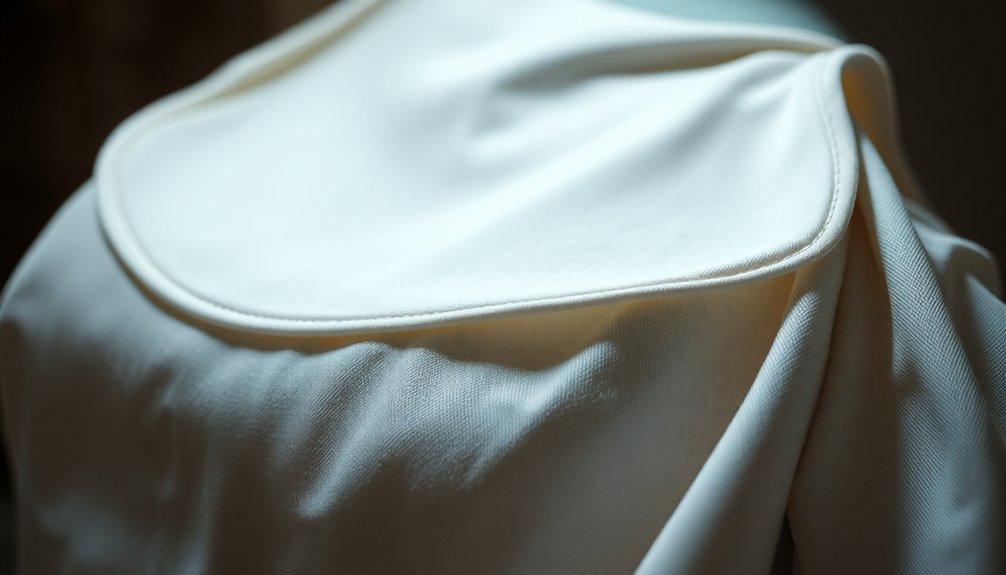
While you mightn't think about it at first glance, the yoke plays a crucial role in garment construction by reinforcing the shoulders and upper back. It guarantees durability and structural integrity, especially in shirts.
The yoke helps with proper draping, following your body's natural curves, which allows for ease of movement and comfort. By incorporating darts into the yoke design, you can achieve a tailored fit that eliminates excess fabric and enhances the garment's silhouette.
Additionally, a well-constructed yoke conceals raw edges by sandwiching fabric, resulting in a cleaner finish and preventing fraying. Ultimately, a well-designed yoke contributes to a smooth fit across your shoulders, fundamental for comfort and mobility in your clothing.
Aesthetic Appeal of Yokes in Clothing
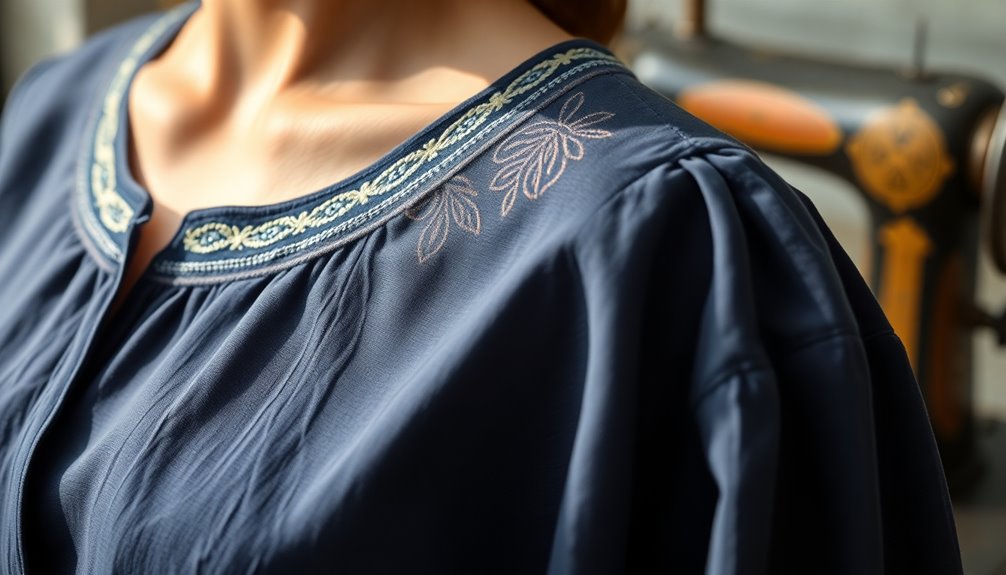
When you think about yokes in clothing, consider how they can elevate a garment's visual interest.
Decorative design elements, like unique fabrics or embroidery, can transform a simple piece into something eye-catching. These intricate details not only enhance the visual appeal but also showcase the craftsmanship involved in the creation of the piece. Understanding how these design elements can be implemented effectively, including techniques like notches in sewing explained, can elevate a standard item to a work of art. When combined with thoughtful styling and personalization, decorative designs can make a lasting impression and highlight the wearer’s individuality.
Decorative Design Elements
Yokes serve as an enchanting design element in clothing, transforming simple garments into visually striking pieces. You can enhance the aesthetic appeal of your creations by incorporating intricate embroidery or embellishments into the yoke.
Using contrasting fabrics not only draws attention to the upper body but also adds depth to the overall design. Unique yoke shapes, whether pointed or curved, can influence the silhouette of a top or dress, making bold fashion statements.
Furthermore, decorative yokes act as a canvas for creative expression, inviting experimentation with textures, colors, and patterns. The beauty of yokes often reflects cultural influences, showcasing detailed smocking or pleating that highlights craftsmanship and artistry in traditional garments.
Enhancing Visual Interest
To create garments that truly stand out, incorporating yokes as a design feature can make all the difference. Yokes serve as a focal point, often using contrasting fabrics or colors that draw attention to your shoulders and neckline.
You can enhance the visual appeal of tops and dresses with decorative elements like embroidery, pleats, or unique shapes. The placement and style of yokes greatly influence a garment's silhouette, allowing for either a tailored or relaxed look.
Plus, yokes give you the freedom to experiment with various materials, incorporating textures and patterns that elevate the piece's aesthetic.
Historically, intricate embellishments on yokes showcased craftsmanship and added character, making them a timeless choice in clothing design.
Yoke Variations Across Different Garment Types
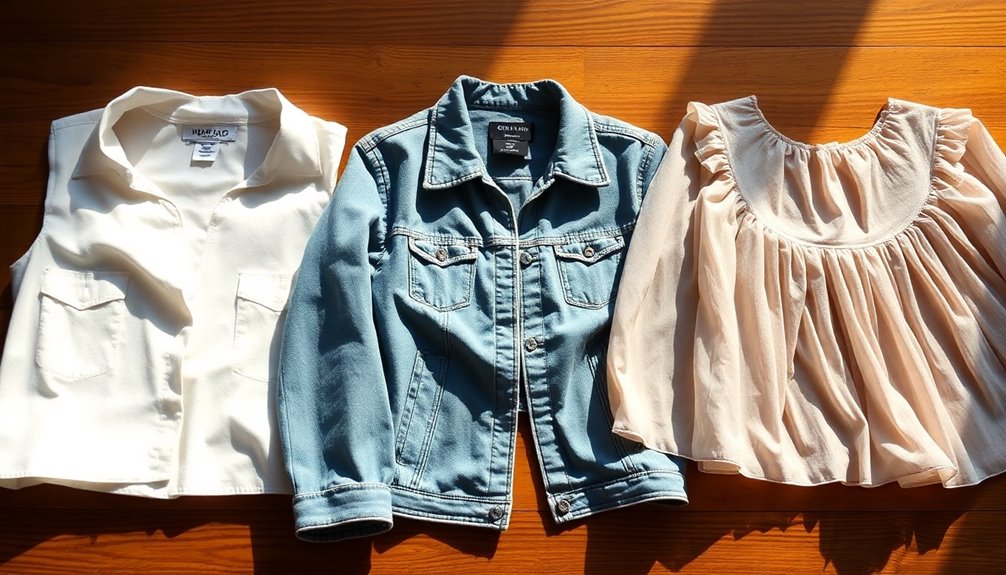
Although yokes may seem like a simple design element, they play an essential role in shaping various garments. You'll notice yoke variations across different types of clothing, contributing both structure and style.
| Garment Type | Yoke Function |
|---|---|
| Shirts | Provides structure and hides raw edges |
| Dresses | Creates design interest with gathers |
| Trousers/Skirts | Absorbs dart values for a streamlined fit |
In outerwear, yokes add functional support and decorative flair, enhancing jackets and coats. The choice between curved or pointed yoke variations can markedly impact how the garment fits and its overall aesthetic. Understanding these variations helps you choose the right design for your sewing projects.
Pattern Making Techniques for Yokes
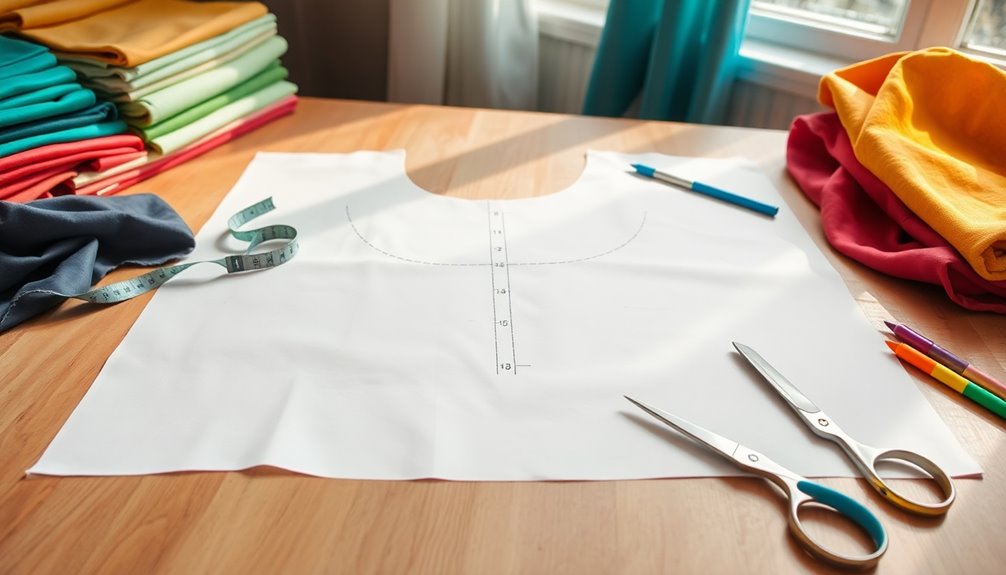
Understanding yoke variations lays the foundation for mastering pattern making techniques. You can derive yoke patterns from basic women's bodice blocks, customizing them to fit your design preferences.
When drafting, draw a line above the bust for the front yoke and across the shoulder blades for the back yoke to guarantee proper placement. If you're creating a merged yoke design, extend the back yoke pattern piece by about one inch to achieve a seamless shift.
Don't forget to incorporate a back shoulder dart; it helps absorb excess fabric and enhances the garment's shape. Experiment with different yoke shapes, like curved or pointed designs, to greatly impact the aesthetic appeal and silhouette of your finished piece. Well-designed interiors can reflect individual tastes and preferences, much like how unique yoke designs can showcase your personal style.
Sewing Methods for Attaching Yokes
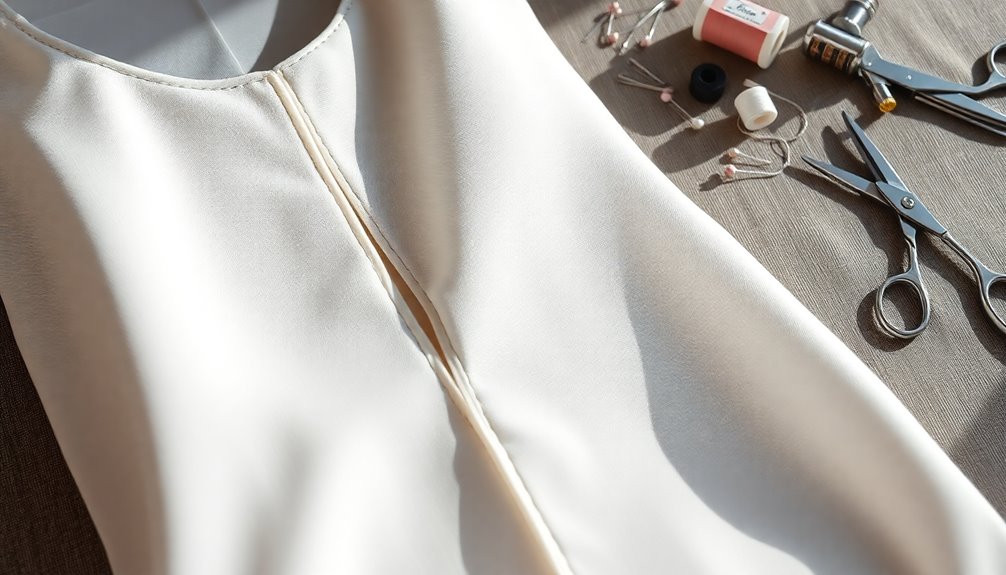
When you're ready to attach a yoke, start by matching and pinning the outside yoke to the shirt back with right sides together, ensuring everything aligns for a clean finish.
After that, pin the inside yoke to the wrong side of the shirt, effectively sandwiching any pleats or gathers between the yoke layers.
Use a seam allowance of about 3/8 inch for durability and ease of fitting, and grade the seams to reduce bulk.
A popular technique is the burrito method, where you roll up the yoke layers with the bodice, making it easier to turn the garment right side out.
Finally, always press the yoke after stitching to achieve a polished appearance, enhancing your back pattern pieces.
The Influence of Yoke Design on Fit and Movement

Yoke design considerably influences how well a garment fits and moves with your body. The right yoke guarantees your shoulders and upper back follow your natural curves, enhancing comfort and mobility.
Here are some key aspects to reflect on:
- Darts: Incorporating darts can absorb excess fabric, providing a smoother fit across the back.
- Shape: The yoke's shape—whether straight, curved, or pointed—affects how the garment drapes and moves.
- Support: Yokes can distribute weight evenly in the shoulder area, reducing friction during movement.
- Customization: Adjusting yoke size based on individual measurements enhances overall fit and accommodates various body shapes.
Future Trends in Yoke Design and Fashion
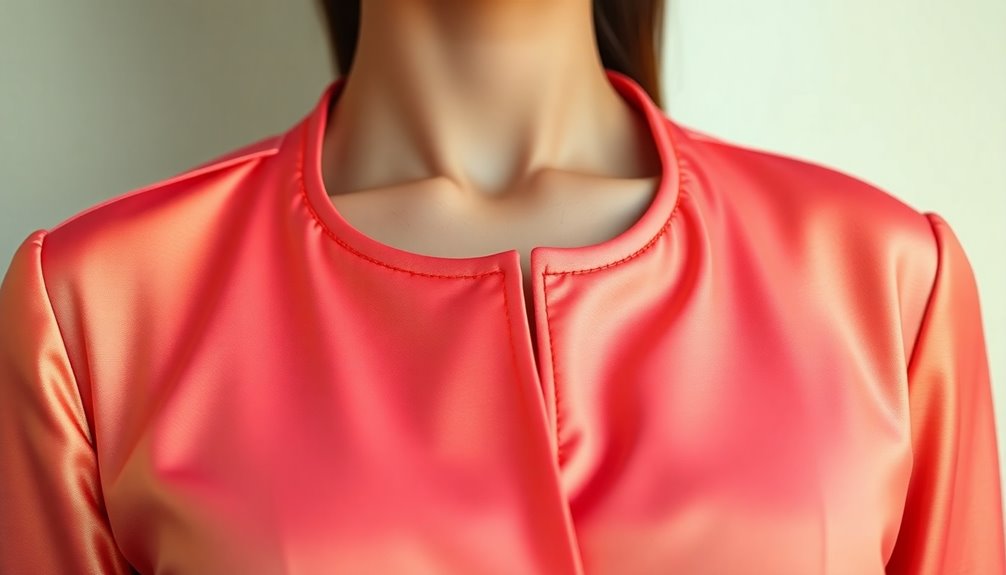
As the fashion industry evolves, yoke design is set to embrace innovation that merges functionality with style.
Technological advancements like 3D printing are allowing for more intricate and customizable yoke structures, making garments not only unique but also tailored to individual preferences.
Sustainable fashion trends are pushing you to seek eco-friendly materials for yokes, promoting longevity and reducing environmental impact.
You'll notice innovative yoke styles that blend traditional craftsmanship with modern aesthetics, catering to contemporary tastes.
Additionally, the rise of inclusive sizing means yokes will accommodate a wider range of body shapes, enhancing comfort.
Fashion houses are experimenting with contrasting fabrics and textures, transforming the yoke into a focal point of creative expression in your wardrobe.
Frequently Asked Questions
What Is the Purpose of a Yoke in Sewing?
The purpose of a yoke in sewing is to provide structure and shaping to your garment. It helps absorb dart values, ensuring a smoother fit that enhances your silhouette.
You'll find that yokes improve comfort and mobility by distributing fabric across your shoulders and upper back.
Plus, they can add a decorative touch, allowing for creative styling with contrasting fabrics or embellishments that elevate your overall design.
How to Make a Yoke Pattern?
To make a yoke pattern, you'll want to start by drawing a line above the bust for the front yoke or at the shoulder blades for the back.
Merge the front and back pieces at the shoulder line, extending the back yoke by 1 inch for a seamless fit.
Don't forget to add seam allowances and consider incorporating darts for shaping.
Get creative with pattern manipulation to craft unique shapes that enhance your design!
What Is a Yoke on a Pair of Pants?
A yoke on a pair of pants is that horizontal panel at the back, just below the waistband. It gives structure and shape, creating a smoother fit across your back.
You'll notice it helps absorb dart values, enhancing comfort and mobility.
Yokes can have various designs, like straight or curved edges, which influence both fit and style.
This feature guarantees your pants fit better around the hips and waist, making them more flattering.
Is a Yoke Necessary?
Whether a yoke's necessary really depends on your design goals.
If you want better fit and structure in your garment, especially around the shoulders and upper back, incorporating a yoke can be beneficial. It enhances movement and can provide a polished look.
However, if you're aiming for a simpler design or working with certain fabrics, you might skip it.
Just keep in mind that avoiding a yoke may impact fit and overall comfort.
Conclusion
In the world of sewing, the yoke isn't just a functional detail; it's a game-changer. Imagine a garment that flows effortlessly with your every movement, enhancing both comfort and style. As trends evolve, the yoke's role could shift dramatically, merging tradition with innovation. Will you embrace these changes and experiment with yoke designs in your next project? The possibilities are endless, and your creativity might just lead to the next big thing in fashion.
